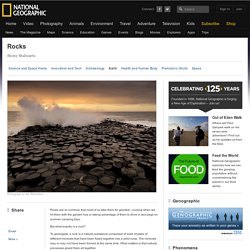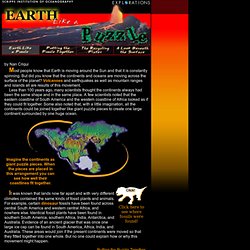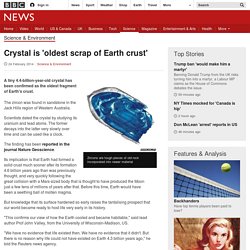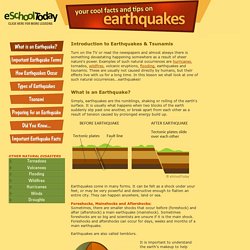

Rocks, Rock Information, Facts, News, Photos. Rocks are so common that most of us take them for granted—cursing when we hit them with the garden hoe or taking advantage of them to drive in tent pegs on summer camping trips.

But what exactly is a rock? To geologists, a rock is a natural substance composed of solid crystals of different minerals that have been fused together into a solid lump. The minerals may or may not have been formed at the same time. What matters is that natural processes glued them all together. There are three basic types of rock: igneous, sedimentary, and metamorphic. Extremely common in the Earth's crust, igneous rocks are volcanic and form from molten material. Typically, granite makes up large parts of all the continents. Granite rocks can be very old. Rock Formation. Earth Science. Plate Tectonic and other Geological Animations. LISS - Live Internet Seismic Server. These data update automatically every 30 minutes.

Last update: April 13, 2014 07:09:31 UTC Seismograms may take several moments to load. Click on a plot to see larger image. CU/ANWB Willy Bob, Antigua and Barbuda CU/BBGH Gun Hill, Barbados CU/BCIP Isla Barro Colorado, Panama. Global Maps. Observe an animation of the breakup of Pangaea. Plate Tectonics - Earth Like a Puzzle - Children learn about plate tectonics, earthquakes, and volcanoes at this site in Scripps Institution of Oceanography.
By Nan Criqui Most people know that Earth is moving around the Sun and that it is constantly spinning.

But did you know that the continents and oceans are moving across the surface of the planet? Volcanoes and earthquakes as well as mountain ranges and islands all are results of this movement. Less than 100 years ago, many scientists thought the continents always had been the same shape and in the same place. A few scientists noted that the eastern coastline of South America and the western coastline of Africa looked as if they could fit together. Putting the Puzzle Together... Teaching Geological Time Eras To Students With Help From This Video. QuakeFeed Earthquake Map, Alerts and News - World Earthquakes Displayed on Esri Maps. Earth 100 Million Years From Now. Crystal is 'oldest scrap of Earth crust' A tiny 4.4-billion-year-old crystal has been confirmed as the oldest fragment of Earth's crust.

The zircon was found in sandstone in the Jack Hills region of Western Australia. Scientists dated the crystal by studying its uranium and lead atoms. The former decays into the latter very slowly over time and can be used like a clock. The finding has been reported in the journal Nature Geoscience. Its implication is that Earth had formed a solid crust much sooner after its formation 4.6 billion years ago than was previously thought, and very quickly following the great collision with a Mars-sized body that is thought to have produced the Moon just a few tens of millions of years after that. But knowledge that its surface hardened so early raises the tantalising prospect that our world became ready to host life very early in its history. "This confirms our view of how the Earth cooled and became habitable," said lead author Prof John Valley, from the University of Wisconsin-Madison, US. Protected forests destroyed by Mt Kelud`s eruption.
Photo document of volcanic ash soaring out of Kelud visible from a distance of five kilometers in the hamlet of Kampung Newer, Sumber Sari, Nglegok, Blitar, East Java, on Friday (Feb. 14, 2014).

(ANTARA/M. Risyal Hidayat) Total loss suffered by the state is estimated to be at Rp 19 billion. " Related News Blitar, East Java (ANTARA News) - Mount Keluds eruption last Thursday has damaged 70 percent of protected forests within a radius of three kilometers around the volcano, a forestry company spokesman stated here on Tuesday. What is an Earthquake.
Introduction to Earthquakes & Tsunamis Turn on the TV or read the newspapers and almost always there is something devastating happening somewhere as a result of sheer nature's power.

Examples of such natural occurrences are hurricanes, tornados, wildfires, volcanic eruptions, flooding, earthquakes and tsunamis. These are usually not caused directly by humans, but their effects live with us for a long time. In this lesson we shall look at one of such natural occurrences...earthquakes! What is an Earthquake? Simply, earthquakes are the rumblings, shaking or rolling of the earth's surface. Earthquakes come in many forms. Foreshocks, Mainshocks and Aftershocks: Sometimes, there are smaller shocks that occur before (foreshock) and after (aftershock) a main earthquake (mainshock). Earthquakes are also called temblors. It is important to understand the earth’s makeup to help understand earthquakes better. The Mantle is semi-molten rock, also called magma. Natural disasters. Earthquakes(Earthquakes are not associated with weather, but instead are natural disasters.)

What is an earthquake? Earthquakes are the shaking, rolling or sudden shock of the earth’s surface. They are the Earth's natural means of releasing stress. More than a million earthquakes rattle the world each year. The West Coast is most at risk of having an earthquake, but earthquakes can happen in the Midwest and along the East Coast. Click Here to learn more about earthquakes from USGS. Natural disasters. Earthquakes (National Geographic)